April 2008 Archives
As a new feature I'm going to review playing-cards. There are quite a few different packs available and finding information about them is hard. So, here's something and more to come, especially if I get any encouragement.
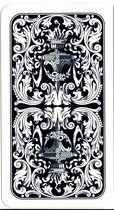
Piatnik Tarock 54 Blatt Nr. 1935. This is an Austrian-style 54-card Tarock pack. That is, 22 trumps and 32 other cards. As usual, there are king, queen, knight and jack in each suit and 7-10 in black suits and 1-4 in red suits. Cards have no indices, but the court cards are easy to tell from each other and with pip cards, the lack of indices is only problem for the black cards. In most games the pip cards are almost completely insignificant, so it often makes no difference whatsoever whether you hold eight or nine of clubs.
The trumps have Roman numerals. To me this seems more authentic for some reason than just numbers. The pictures show vaguely Eastern European countryside life. The cards are printed well and pictures have beautiful colours. The cards are slightly oversized compared to regular Bridge or Poker cards and of typical Piatnik quality.
This pack is identical to pack number 1936 except for the backs. 1936 has a subtle line pattern, this has baroque ornaments in blue and white. 1936 is my current favourite pack for 54 card games, and for all practical reasons 1935 is just as good.
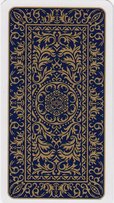
Carta Mundi Jeu de Tarot - 78 Cartes. This pack has no identification number or other details, but the back pattern is called Versailles so if you search for that, you should be able to find a whole family of backs with the same design. The pattern is blue and gold floral design, but apparently there is also a red and gold variation available. I'm not sure if there's a red and gold tarot pack, though.
In any case, this is a full 78 card pack, that is 22 trumps and 56 cards otherwise. All cards bear indices in four corners; court cards have French indices (R, D, C and V). The trumps have what is apparently a French standard pictures, but here the pictures look better than in the other French tarot pack I have. The colours are better. The trumps are numbered with Arabic numerals.
Included with the pack are the rules and a scoring card for French Tarot. The card quality is excellent. This is a very good pack for playing almost any Tarot game and my standard suggestion to people who wish to buy exactly one Tarot pack and thus want maximum versatility.
Another Thursday session, this time on Tuesday because the Vappu festivities on Thursday mean the university is closed.
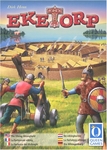
After a quick round of Coloretto we bit into Eketorp. Whether to play this or not was a bit of a question, since from reading the rules I knew I would not enjoy the game. However, I decided there is some value having played the game - at least I can now write a review of it, since it's coming out in Finnish.
The reason why I don't like the game lies in the main mechanics: double-guessing and blind bidding. That's it. First players allocate their viking warriors on different fields. If you're lucky and choose fields nobody else is taking, you get good rewards. If you fail to do that, you'll have to fight and win to get anything. Fighting is done by playing battle cards with values from 1 to 6: bigger card wins, then players exchange cards.
This is repeated for ten rounds. It's a long session of rather tedious repetition. The box says 45-60 minutes, our game took 90 minutes. I could tolerate a game like this for 30 minutes. It'll take some convincing to get me play this one again. It's not a bad game if you like this sort of thing: one person in our game enjoyed it a lot.
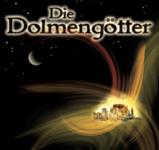
After Eketorp we played one quick round of Die Dolmengötter, this time with all newbies except me. The Ollis offered tough opposition: the top three had scores of 73, 72 and 70. Tapani took the fourth place 20 points behind... Dolmengötter gets better every time. This time I made some blunders, didn't play my druids well, but managed to survive anyhow. I did one teleport jump without leaving a stone, that was a critical move which ensured my win even though I had to pay a point there. Interesting, interesting...
Remember the online Chess timer I mentioned before? It was discussed on the Finnish Board Game Society forums and the lack of multi-player option was noted. Well, it didn't take many days before Zumba Gametimer was online. Check it out, if you need a multi-player timer.
We got a Wii last week. The final reason was Mario Kart Wii - it's one of my favourite series, I've enjoyed it on both GameCube and particularly on DS. The Wii version is the best, however, for several reasons.
Wii has been on our "to buy" list since it came out, it was obvious we would buy it at some point. It's the only console I'm at all interested in. PS3 and Xbox 360 have simply nothing at all to offer me, yet I've been quite intrigued by Wii. I don't care about flashy graphics or most games, I want clever gameplay and few choice hits I'm going to play a lot. Mario Kart Wii fits the bill, and I expect Wii Sports (bowling in particular but also tennis) to entertain me for quite a while as well.
Mario Kart Wii is a very good game. The gimmick is the Wheel, where you insert the Wii remote and then go driving. It's funny, it'll change your driving style a bit, but it works. It takes some getting used to, but I like it. It's not a cheap gimmick, but actually a rather pleasant way of driving.
There's some other new stuff as well. There are now bikes as well: 100 cc class is at first bikes only and 150 cc is bikes or karts. A local game critic didn't like the bikes, but I love them - right now if I have a choice, I'm riding a bike. They just work very well with my driving style.
The new tracks are fun, there are several rather clever and funny tracks in the new set and the recycled set is well chosen. Many favourites are back, with some new twists. The new tracks remind me of F-Zero GX at several places... There's plenty of speed and some pretty tough challenges. The latest version of Rainbow Road is just fiendish.
There's a ton of chaos in the game, it's much worse than before if you don't like it. There's 12 karts or bikes in each race and some new and nasty objects (POW blocks and the thunderclouds in particular), so there's trouble ahead! Winning races is hard at 150 cc, because someone's blasting you with shells or something all the time. Skip this game if you can't stand the chaos or are easily frustrated...
What really works is the online play. I tried online matches with DS, but that wasn't very good. There's little point in running four race competitions when your opponents are going to drop out as soon as they figure out you're better. Here it's just one race at a time, with up to 12 players. Players have rankings, and if you suck, you don't have to win to improve your rating (right now, I think if I only could make it fifth or so, I would improve my rating in most cases). That makes sure everybody has motivation to do their best all the time.
One feature I really like is ghost races. You can get a ghost run that's slightly better than your current record and try to beat that. That gives the game so much extra mileage. I used to do something similar with Tommy in F-Zero GX: we had an online leaderboard where we recorded our times. That competition kept me playing F-Zero GX for a long time after I had unlocked all the cups. Here it is built in the system. You can compete with your friends, find random opponents at your level, challenge the continental or world champion, race against staff ghosts, see how your times compare to other people... All very cool stuff, and everything works without any trouble at all.
So, I expect to play Mario Kart Wii for a long time, because the regular cups will offer more challenge than before and the online play will add to that. This all means the game is well worth the money and almost alone enough of a reason to get Wii.
The Generic GeekList - The only GeekList you'll ever need.
Images for Desktop Wallpaper - Need desktop wallpapers? Sorry, the Generic GeekList won't help, but this one will!
Jonathan Rose has done a pretty neat JavaScript Chess Timer. It's easy to use, looks neat and seems to work pretty well (haven't tried it in action, though).
I joined The International Playing-Card Society recently. I have little interest in participating the activities, but I was curious about Playing-Card, their journal. I received the three back issues of this subscription season yesterday and I'd say they're worth the money. I mean, I haven't subscribed to Counter, because I can read board game stuff online more than enough. However, The Playing-Card has material that isn't as easily available online.
There's tarot reviews in each issue. One of them pointed me to Tarot History, which is a web site about French Marseille tarot. They've recently published a beautiful new edition of Jean Noblet's Marseille tarot pack from 1650. It looks really great: it has the original line drawings and new, bright and beautiful colours. You can get a hand-made edition of the trumps as well (there are neat pictures of the colouring process).
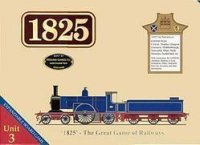
I organized a game of 1825 Unit 3 today at the local library. We ended up playing Unit 3, because Olli was the only one who came... Rest were busy or not willing to travel all the way to the suburbs. It's not a big deal, though, as Unit 3 is made for two players.
Unit 3 covers Scotland and Northern England, from Maryport in South to Aberdeen in North (a regional kit covering the Highlands was planned, but hasn't been published yet - I wonder if it's ever coming). Glasgow stands in the middle and is a central point, as all three major railroads (Caledonian, Northern British and Glasgow and South West) start there. Of the three minors, two (Highlands and Great North of Scotland) start in the northern edge and one (Maryport & Carlisle) starts in the south.
In the beginning one of the players will take NBR and the other takes CR, so Olli got NBR and I got CR. NBR started heading north, while CR aimed towards Edinburgh. NBR didn't pay dividends like CR, so eventually NBR's share value dropped while CR climbed to 100 pounds per share. I was able to sell few shares to invest in GSWR, the third major. In retrospect, that's something the NBR player probably shouldn't allow, as CR and GSWR can play really well together. They have excellent synergy.
So, CR and GSWR built the south and east side of Glasgow full of cities. Very effective! Meanwhile NBR connected to Aberdeen, where GNS started, operated by Olli alone. GNS was pretty good for Olli: it has very little room for expansion, because it can only run one train (Olli would've bought a train from NBR otherwise), but it kept running constant dividends to Olli, raising the share value while doing that.
In the end CR and GSWR were running few trains each. CR made 320 £ and GSWR 440 £ per run - not bad at all. NBR was very mediocre (losing the 2 trains hurt it pretty bad, even though it bought a 3 train for 200 £ from GSWR - thus helping GSWR to get a 5 train). Olli started the M&C in the south, but it didn't do much as the game was soon over.
So, in the end, I won. We thought that was obvious, but the final scores were 5294 - 4993, much closer than we expected. While I had the two heavy hitters, Olli had shares for both of them. I had no shares of GNS, which was pretty effective money-maker for Olli.
In retrospect few mistakes were obvious. Of course Olli should've started HR instead of M&C - he would've won had he done that. Then again, I should've built more stations with CR and GSWR, blocking GNS at Perth, for example. So, I could've lost but I also might've won with a wider margin as well. It was a learning game for both of us, so no wonder we didn't play the sharpest game possible.
But it was fun! It took us about 30 minutes to do the setup and go through the rules (Olli had played another 18xx once before) and then two and half hours to play the game. Not bad. Instead of paper money or poker chips we used pen and paper bookkeeping, which worked well. There's a lot of calculation, though, and counting the bank was a bit of a pain. Still, it's a fairly nice method and I would use it again. The best way would still be a computer spreadsheet (this was basically an analog version of spreadsheet).
It was pretty smooth sailing, but promoting tiles gave us some headache. We played it correctly in the end: when promoting tiles, you need to maintain all the connections leaving the hex, but you don't have to create all the connections entering the tile. That is, you can place a tile so that tracks run to an empty side of the tile. That's fairly critical for Glasgow on this map. There's a bit of a confusion in the rules, as they say you can't run rails to a blank side of a brown hex - to figure it out one must realize that the brown tiles players play aren't actually brown, they're russet. Brown means the brown tiles that are printed on the board. Slightly confusing, I'd say!
We finished off the afternoon with a quick match of Schotten-Totten, which I also won - and it was a close game as well, 5-4. Rather excellent session in general.
I did a GeekList: So, who else is a builder? It's about how building stuff is what makes me happy in games. Take a look, comment and add!

Yesterday's game session was mostly about Shogun, the Dirk Henn game of warring Japanese daimyos in the 16th century. It's a redevelopment of Wallenstein, which I've played once as play-by-web (and I didn't like it). Now most complex games are better learnt by the board, so I was willing to give Shogun a go.
Shogun is a pretty neat game, but not my favourite. It does several things right: there's a nice economy of scarcity, the simultaneous planning phase is very nice, I like the way the battle tower works (battles are resolved with a clever cube tower device), the whole structure of the game just works pretty well in my opinion.
However, while the game is rather good at what it tries to be, I just don't like the genre. It's a multi-player war game, where players struggle for the different provinces of Japan. You win some, you lose some and in the end you try to win more you lose. Nothing is permanent, anything can be taken from you... it's just not my cup of tea.
There's plenty of interaction and with a midpoint scoring, this is one those games where being in the lead after the first scoring is not a game-winning strategy. Standing out means getting beaten. Of course, one must not hang too far behind: I was dead last after the first scoring and while I played a good second half, I was able to rise one step to third. Petri, who was leading by few points after the first scoring dropped last, mostly because I beat him senseless. That's not nice, but it was the best thing for me: I was able to score quite a few points with the provinces I stole from Petri.
Shogun is a highly chaotic game: there are small inputs of chaos all around the system. The battle tower is chaotic, the actions are resolved in random order, the combinations of player order and special cards are random, there's a random event every round... So planning anything long-term is really, really difficult. That is something one needs to accept when playing Shogun.
So, Shogun is a good game, but not for me. I would play again, but given an opportunity to play something else I would probably skip Shogun.

We didn't have much time after Shogun, but enough for a game of Die Dolmengötter. Everybody had played before, which is always a bonus. It quickly turned out to be my game: I was getting quite a few dolmens on top of the piles. However, Hannu was doing the same, just few steps behind me. Petri and Tero were building their dolmens on the bottoms.
In the end I won, but I had only five points more than Hannu. Tero and Petri were able to catch up a bit, too, Tero lost just five points to Hannu and Petri was two points behind Tero. So, it wasn't quite the slaughter it seemed to be. Hannu still claimed to be completely lost about the game, and I suppose it's no wonder: Dolmengötter is a clever game. I started to feel in control of the game, now that I've played four games.
In any case, I'm seriously fond of the game. It's very quick, but very meaty for a 20-minute game. I upped my rating to nine, because this gem certainly deserves it.
Tomorrow I'm meeting at least Olli for some 1825 action. Expect reports on Sunday!
Boardgaming Finland podcast interviewed me and reviewed my book in their latest episode. Unfortunately the interview and review are in Finnish, but if you understand Finnish and want to hear someone else's opinion of the book, Cane's review is definitely worth listening (it helps he gives the book an excellent review).

We were planning to play cards this time to celebrate my book, which was finally released last Friday. Well, that didn't happen, thanks to rather diminished number of players (four), including one particular person who doesn't fancy traditional card games. So, card games were restricted to Flix Mix.
So, we started with Airships (aka Giganten der Lüfte), a die game from Andreas Seyfarth. Players collect cards by rolling dice and hoping to roll high enough. Cards provide more dice and various bonuses and eventually points. It's all fun and games like any dice game, but fell flat for the same reasons.
Basically, die rolling just isn't that much fun. Especially when someone else is having the dice. Our game took 60 minutes, so with four players you spend 15 minutes playing and 45 minutes watching something that isn't very interesting. Talk about fixed fun. This is probably better with just two.
In our game, Hannu realized the value (high) and scarcity of point-producing points best and sailed to an easy victory.

Next we played something much better: Die Dolmengötter. The more I play this one, the more I like it. I was able to use my experience to actually win the game, too. This is such a clever and a swift-moving game, ours took just 20 minutes or so. And it's alll good, pure fun. My current rating is eight, and I'm seriously considering upping this to a nine. A rare gem. I'm rather glad this fell flat in the Leppävaara game club and I was able to buy Tommy's copy for a low price.
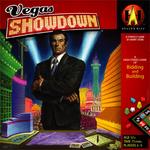
Vegas Showdown closed the evening. We played with a variant where start player rotates, except when someone chooses to renovate or publicize, in which case the first player to do that each turn gets the button. I'm not sure I like the change, but it's not a huge deal, I can play either way.
I still like this, the economics in this game are rather interesting and mellow in a good way.
Oops. I noticed I had missed blogging our previous Thursday game session. You see, I got sick (stomach flu, fortunately Johanna and Nooa avoided the same bug) the night after that, so I had something else to think about for a while... But here it is, just in time before our next session!
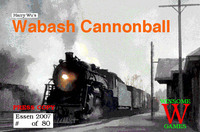
After a quick San Juan, it was time for Wabash Cannonball. I played a bad, bad game, losing to both Hannu and Riku... I did beat the newbie in the table, but that's not a major achievement. I blame Hannu, of course, whose whole purpose was to crush me down right away. Ok, so maybe I screwed up when I wasted all my money in the initial auction. I won't do that again, I promise. Tough game, and it certainly proved that it's possible to take someone down if you want to. Then again, at the same time it's pretty hard to take a leader down once he's in the lead, or at least I never succeed when I try that.

I wanted to revisit Canal Mania. You know, the last time I said "in the future, I'll probably prefer four - or five, if everybody plays fast." Let's make that "I'll prefer three, or four if everybody plays fast." We had four this time, and the downtime was too much for my (short) nerves.
We were able to finish the game in 90 minutes, but it took some pushing in the end when time started to run out. I was able to win the game pretty easy, as I got lucky with contracts and built a nice, large contiguous network around Oxford. It worked really well, I was constantly making excellent shipments and also receiving few points per turn from other players goods movement. Of course, in Canal Mania it's pretty hard to plan something like that, you need to be lucky with the contracts, but if you can make it work, you'll do well.
So, I still like the game, but I also think it's a tad long for what it is. Even 90 minutes feels like a bit too much, to be honest. I'm going to give it few more chances and when Ropecon is in August, I'm selling the game if it doesn't thrill me by then.
Oh my, another quarter gone! The previous one was good, how about this one?
Wabash Cannonball is the hottest of the hot, and no wonder. I've loved every game so far. I'd like to try a five-player game at some point, to see how that changes the game. And of course more games with three and four! Fortunately the locals are in agreement about the excellence of the game. Right now, by the way, Finns have the highest average for Wabash at Geek.
I'm really interested in seeing how Wabash compares with Pampas Railroads (preorder, preorder, good people!). I'm such a fan of short and action-packed games that Pampas needs to be really good to stand up to Wabash. We'll see...
Black Vienna - After my visit to Jyväskylä, it's no wonder Black Vienna is on this list. We had some really good time with this game, and I'm taking the game with me next time I go (unless they've done their own copy, which is likely). On the other hand, I'm not sure I'm that interested in playing this game elsewhere.
Race for the Galaxy is an obvious addition to the list. Seven more games, and I want more. This hasn't been a huge hit, but to me this is still the top of 2007, despite Wabash.
Cuba makes it to the list after three games. It's unlikely to appear again, but we'll see.






